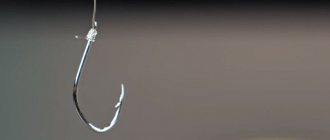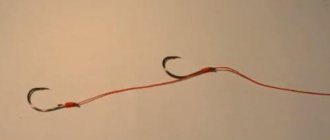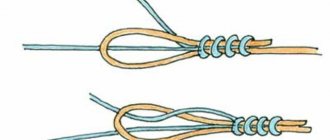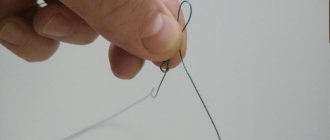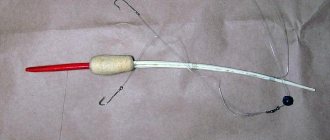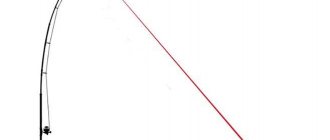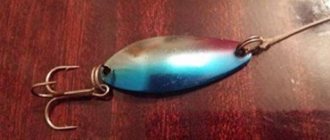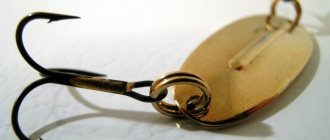how to tie a fishing line to a fishing line - the “Bloody” fishing knot
fishing video "Bloody"
The fisherman’s knot “bloody” will allow you to tie a fishing line to a fishing line that does not differ much in diameter (no more than twice). This fishing knot is quite easy to tie and retains up to 75% of the strength of the fishing line. If one line is thinner than the other, then the number of turns of the thin line should be greater.
The “bloody” fishing knot is very neat, has a small diameter, and easily passes through the spinning rod’s throughput rings. The knot is very versatile, it ties both monofilament and “ braided ” in any combination (for “ braided ” two or three turns are enough).
This fishing knot owes its creepy name to its use for punishing particularly guilty sailors on English ships during the time of Columbus. This knot was used to tie a thick knob at the end of the whip, which left bloody wounds on the unfortunate man’s back.
You will be interested in reading about fishing knots and how to tie a hook
quick transition to the fishing tackle section
| fishing knot "Bloody" - characteristics | |
| An excellent knot for tying a leash to a float rod or bottom. | |
| Types of fishing line | Monofilament, braided |
| Knot tensile strength | 70-75% |
| Node purpose | Tie the fishing line to a fishing line that differs in diameter by no more than 2 times. Tie the leash to the fishing line. Tie the braided line to the monofilament thread. |
how to tie a fishing line to a fishing line - fishing knot “Bloody” picture 1.
Place both lines parallel. Wrap one line around the other 4-6 times. The thinner the line, the more turns there should be: up to 0.15 - 6 turns; up to 0.27 – 5 turns; 0.3 and thicker - 4 turns. For braiding, 2-3 turns.
how to tie a fishing line to a fishing line - fishing knot “Bloody” picture 2.
Wrap the end of the fishing line back, and insert it between the two fishing lines until the turns.
how to tie a fishing line to a fishing line - fishing knot “Bloody” picture 3.
Take another line and make the same turns as in step 1.
how to tie a fishing line to a fishing line - fishing knot “Bloody” picture 4.
Thread the end of the second line through the middle loop. Make sure that this end of the line is threaded in the opposite direction from the end of the first line.
how to tie a fishing line to a fishing line - fishing knot “Bloody” picture 5.
Moisten the knot with saliva and tighten the long ends. Trim off any excess line. The “bloody” fishing knot is ready.
Method No. 3: “Carrot Knot”
In this way, you can tie any fishing line together, regardless of its diameter and material. The Carrot knot is very reliable and fits perfectly through the rod guides. Knot strength is 100%. That is, this knot does not reduce the strength of the fishing line at all! Excellent for tying a shockleader to a fishing line, so it is often used when fishing for carp. With such a knot you can tie fishing line to fishing line without losing the strength of the tackle.
Node execution:
- We will assume that, in this case, we tie the shock leader to the fishing line (for convenience).
- We make a simple knot at the end of the shock leader, but do not tighten it completely, leaving a loop.
- We thread the fishing line into this knot with a margin of about 30 cm.
- We wrap the line 10 times around the shock leader away from the knot, and then the same number of turns back to the knot.
- Now we thread the tip of the fishing line into the loose loop on the opposite side.
- Having pre-wetted it, tighten the knot, stretching the shock leader and fishing line in different directions.
- Trim off the excess ends. The node is ready.
The site ryba4ok.ru suggests you remember these ways to tie two fishing lines. If it’s difficult to remember, add this article to your bookmarks and it will always be in quick access. The methods are the most reliable and are the ones used by experienced fishermen. Good luck with your fishing and - no tail, no scales!
how to tie fishing line to fishing line - "Bloody Reverse" fishing knot
fishing video "Bloody Reverse"
The Bloody Reverse Fishing Knot is a very effective knot for tying line to line. The knot is suitable only for thin and medium monofilament threads (up to 0.4 mm in diameter), and in this case it has much greater strength than the “Bloody” fisherman’s knot. For the “braid” it is better to use other fishing knots.
This fishing knot allows you to tie fishing line to fishing line with different diameters. The "Bloody Reverse" fishing knot should have from four to eight turns in each direction, depending on the thickness of the line (the thicker the line, the less).
| fishing knot “Bloody Reverse ” - characteristics | |
| The “Bloody Reverse” fishing knot allows you to tie a leash to the main line on a float rod, and in other cases when you need to tightly tie a thin line. | |
| Types of fishing line | |
| Knot tensile strength | 90-95% |
| Node purpose | Tie monofilament no thicker than 0.4 mm in diameter. |
how to tie a fishing line to a fishing line - fishing knot "Bloody Reverse" picture 1
Make 4-8 turns around the other with the end of one line.
how to tie a fishing line to a fishing line – “Bloody Reverse” fishing knot picture 2
Take the outermost coil with your fingers (so that the coils do not fly off). Make the same number of turns in the opposite direction with the same end of the line.
how to tie a fishing line to a fishing line - fishing knot “Bloody Reverse” picture 3
Pull the end up and pass it between the two lines.
how to tie a fishing line to a fishing line - fishing knot “Bloody Reverse” picture 4
Don't touch the first node yet. On the other line, make a second knot of the same type.
how to tie a fishing line to a fishing line - fishing knot “Bloody Reverse” picture 5
Carefully tighten the fisherman's knot. To do this, first pull the long ends of the lines, then the short ones, and so on several times. Trim the ends. The "Bloody Reverse" fishing knot is ready.
How to properly tie a leash to the main line for different conditions
Not only novice fishermen wonder how to properly tie a leash to the main fishing line, but also experienced fishermen. This is due to the fact that improperly fastening the leash often leads to loss of catch.
Every angler should know that fishing line has its own certain strength , which it gradually loses, and a knot can reduce this parameter by up to 50%. Therefore, it is very important to knit leashes correctly. For these purposes, you need to use special fishing knots connected according to certain patterns.
So, you need to start with the fact that each fishing knot is necessarily characterized by tensile strength . For example, you can take monofilament, which provides a strength of 5 kg, but in water it can withstand a fish resistance of no more than 2.5 kg.
There are several basic methods of attaching a leash to the main line that are the most reliable. Some are relatively simple, others are more difficult to master, but with a little practice, they can all be learned.
The most common and simplest method is the “loop-to-loop” . Despite the fact that this fishing knot is very easy to learn, it cannot be said that it has a high level of reliability.
The dressing is carried out as follows:
- At the ends of the main fishing line and the desired leash, 2 elongated loops are knitted.
- The end of the fishing line with the loop must be folded in half and wrapped twice around its axis.
- The loop of fishing line that was originally tied is threaded through the ring that is formed at the end of the entire structure, and then tightened.
- To complete the fastening, you need to fasten the loops of the leash and fishing line together.
The next type of assembly is also quite simple, and most importantly, it can be made right on the spot, without additional equipment.
The dressing is carried out as follows:
- The leash and the main line are applied to each other.
- Now you need to wrap part of the fishing line around the leash and then pull its end to the top.
- This end of the fishing line must be pulled into the resulting loop, but do not tighten it.
- The end of the leash needs to be wrapped around the loop once.
- The knot is tightened.
- Now you need to do the same with the end of the main fishing line and tie it to the leash.
The knot, which is referred to as “Nail” , has a high level of strength, but also great difficulty in mastering it.
You can tie it up as follows:
- You need to tie a stop knot on the main line.
- The leash and cord are parallel to each other.
- The leash line must be threaded under the main line.
- A turn is made around the main line.
- Thread a through object, such as a fountain pen, into the resulting loop.
- Now make several skeins around the main line and pen.
- Now you need to thread the end of the leash through the handle and carefully tighten the knot, while making sure that the turns do not get tangled or overlap each other.
- The remaining part of the leash must be removed.
Another fairly common knot is called “Eight” . In essence, it is quite simple, but at the same time, it confidently attaches the leash and the main fishing line.
The dressing is carried out as follows:
- The leash and cord are laid parallel to each other.
- Now you need to knit a loop that will look like a figure eight, like a “Flemish loop”.
- Now it's time to tighten the knot.
The knotless type of fastening, as is clear from the name itself, does not imply a connection between the leash and the main line using knots . Such a connection requires less time to bind and does not involve any difficulties. It’s worth noting right away that large gear is best secured with knots, and for small baits, this type is most optimal.
A knotless fastener has its undeniable advantages, including saving time and a high level of strength, but there are also disadvantages: it adds extra weight to the tackle, and is often used only for braided lines.
To fix such a fastener, first of all, it must be selected correctly based on the thickness of the fishing line and the dimensions of the bait. The fastener should be a little thinner than the fishing line. To secure it, you need to take a few simple steps:
- Place the eye of the tackle into the eye of the fastener.
- Now the fishing line needs to be thrown onto the hook of the connector, which protrudes to make a double fishing line.
- You need to wind the fishing line onto the connector several turns 3-5 times.
- Now the fishing line needs to be inserted into the second eye and tightened.
- Excess line must be removed.
In addition to the main ways of tying a leash to a braided line or main line, there are several more depending on the type of leash, thanks to which you can secure everything as securely as possible.
There are fishing tackles that require a side leash. They can be used in garlands and other winter accessories. The main problem is that they get tangled in the main line. Therefore, to avoid such a problem, it is very important to tie it correctly.
The simplest and most popular way out of the situation is cambric . In this case, the node type has no special role. It is very important to simply thread the leash through a bright or, on the contrary, transparent cambric, but always a thin one, which will be put on the main line above the knot. In combination with a medium fishing line or a short leash, this method will allow you to enjoy fishing and not be nervous about trifles.
Especially beginners who use this type of leash experience a lot of problems in properly tying a knot that will not unravel.
When installing this type of leash, it is necessary to secure the sinker at the end of the main fishing line, and in the meantime the leash itself must be secured a little higher, approximately at a distance of 15-30 cm.
The simplest and most optimal installation option is “Blind with swivel.” To do this, you need to do the following:
- Tie the sinker to the end of the main line.
- Next, a special swivel is tied a little higher.
- A retractable leash is already attached to the swivel, for which an ordinary fluorocarbon or monofilament fishing line is required.
Thanks to this equipment, the float can easily move along the fishing line to the place where the stoppers will be installed. The leash and sinker are easily immersed during casting.
Thus, with the help of a stopper, it is possible to determine the required depth of the bait. The main requirements in this case are:
- reliability of fixation at the required point;
- there should be no dead fixation so that the depth level can be changed;
- the stopper should not slip into the eye where the float attaches to the fishing line;
- when casting, it should easily pass through the rod guides when casting.
how to tie fishing line to fishing line - “Fisherman’s” knot
fishing video "Fishing"
"Fisherman" knot - an improved "Fisherman" knot is shown here. This fisherman's knot is worked twice, once at each end of the line.
The “fisherman’s” knot forms a simple bend, which has a slight friction of the turns against each other. Therefore, the “Fisherman’s” knot is more suitable for a “braided” knot. The monofilament will slip out of this fishing knot. A variant of the “Fisherman’s” knot with three or four turns is possible, which can be used to tie monofilament.
This simple fisherman's knot is suitable for the beginning fisherman - it is easier to tie than the stronger fisherman's braided knots.
| Knot "Fisherman" - characteristics | |
| With this fisherman's knot you can quickly tie up a torn braid while fishing. | |
| Types of fishing line | "network" |
| Knot tensile strength | 60-70% |
| Node purpose | Tie a braided line. |
how to tie a fishing line to a fishing line - “Fisherman’s” knot, picture 1.
Place the lines parallel. Make a loop of one line around the other.
how to tie a fishing line to a fishing line - “Fisherman’s” knot, picture 2.
Take this loop with your fingers. Pull the end up from the outside of both lines.
how to tie a fishing line to a fishing line - “Fisherman’s” knot, picture 3.
Pass the end behind the second line into the first loop.
how to tie a fishing line to a fishing line - “Fisherman’s” knot, picture 4.
Pass the end into the same loop again.
how to tie a fishing line to a fishing line - “Fisherman’s” knot, picture 5.
Release the loop, grab the ends of the fishing line on which the knot is tied. Moisten it with saliva and tighten it.
how to tie a fishing line to a fishing line - “Fisherman’s” knot, picture 6.
Do the same with the second line.
how to tie a fishing line to a fishing line - “Fisherman’s” knot, picture 7.
Pull the long ends of the lines and pull the two knots together. The "fisherman's" knot is ready.
Albright knot
An incredibly effective and extremely easy knot to tie. Its special advantage is its versatility. For him, neither the diameter nor the size of the fishing line is important.
How to tie an Albright knot:
- You need two lines. From one you make a very ordinary loop, but do not tie it, just attach it to the rope.
- Slide the other one into this loop.
- Pull the rope forward a little and wrap it around another line 9-10 times. It is important to tighten the base of the loop, but not the loop itself.
- You make the end of the rope that was tied into the loop.
- Tighten the connection and cut off excess material.
how to tie fishing line to fishing line - fishing knot "Grapevine"
fishing video “Grapevine”
The fisherman's knot "Grapevine" for tying two fishing lines is based on the fisherman's knot of the same name for tying a hook. For those who are used to tying a hook with this fishing knot, it will be convenient to also tie the fishing line to the fishing line. This knot is slightly stronger than the Bloody fisherman's knot, but inferior to the Centaurus fisherman's knot.
The Grapevine fishing knot is not suitable for tying fishing line to fishing line with different diameters. The greater the difference in the diameters of the lines, the weaker this fishing knot. On identical fishing lines, a correctly tied fishing knot provides 70–80 percent strength. This fishing knot is not recommended for braided fishing. The number of turns should be from three to five, depending on the thickness of the fishing line. The thinner the line, the more revolutions.
| fishing knot "Grapevine" - characteristics | |
| The fishing knot “Grapevine” allows you to tie a broken fishing line while fishing. | |
| Types of fishing line | Monofilament |
| Knot tensile strength | 75-80% |
| Node purpose | Tie the line to a line with a similar diameter. |
how to tie a fishing line to a line - fishing knot “Grapevine” picture 1.
Two lines in parallel. Bend the end of one line back. Take the resulting fold with your fingers.
how to tie a fishing line to a fishing line - fishing knot “Grapevine” picture 2.
Pull the end behind both lines. You will get a loop.
how to tie a fishing line to a fishing line - fishing knot “Grapevine” picture 3.
Inside this loop, make five turns around both lines with the end.
how to tie a fishing line to a fishing line - fishing knot “Grapevine” picture 4.
Grab the long and short end of the line that contains the knot. Pull in different directions and tighten the knot.
how to tie a fishing line to a fishing line - fishing knot “Grapevine” picture 5.
Do the same on the second line.
how to tie a fishing line to a fishing line - fishing knot “Grapevine” picture 6.
Pull both knots by the long ends. Trim the ends. The fishing knot “Grapevine” is ready.
how to tie a fishing line to a fishing line - Centaurus fishing knot
fishing video "Centaurus"
The fishing knot “Centaurus” is suitable for tying fishing line, both of the same thickness and significantly different in diameter. The fisherman's knot is very compact and straight. It is also easy to knit and has a high breaking load. The knot is suitable for braided, monofilament threads in any variation.
| fishing knot "Centaurus" - characteristics | |
| A very versatile fishing knot. They can be used to securely tie line to line on a wide variety of fishing gear. | |
| Types of fishing line | Monofilament, "braided". |
| Knot tensile strength | 90-95% |
| Node purpose | Tie fishing line that varies in type and diameter. |
how to tie a fishing line to a fishing line - fishing knot "Centaurus" picture 1
Place the lines parallel. Wrap one line around the other 3-5 times.
how to tie a fishing line to a fishing line - fishing knot "Centaurus" picture 2
Take the outermost turn in your right hand. Bring the end of the line to the beginning of the turns. Insert the end inside all the turns, as in the picture.
how to tie a fishing line to a fishing line - fishing knot "Centaurus" picture 3
Pull the long and short ends of this line and tighten the first knot.
how to tie a fishing line to a fishing line - fishing knot "Centaurus" picture 4
Make the same knot on the other line.
how to tie a fishing line to a fishing line - fishing knot "Centaurus" picture 5
Pull the long ends and pull the knots towards each other. Trim the ends. The Centaurus fishing knot is ready.
how to tie fishing line to fishing line - fishing knot "Nail"
fishing video “Nail”
The fishing knot "Nail" allows you to tie fishing line to fishing line, which varies in thickness. The name of the fishing knot implies that you will need a nail or similar object (it is more convenient to take a tube - the refill of a ballpoint pen, a cocktail straw, a piece of insulation).
The disadvantage of this fishing unit is that you will need a tube, which is problematic when fishing. But its compactness and great strength make it a universal fishing knot.
The fishing knot “Nail” works well with both monofilament and braided thread in different combinations and with different diameters. The knot passes through the passage rings of spinning rods and other fishing rods without any problems.
| fishing knot "Nail" - characteristics | |
| The fishing knot “Nail” is best used to tie the fishing line to the fishing line at home. Suitable for fishing gear that operates at maximum power - spinning rods, carp gear and the like. | |
| Types of fishing line | Monofilament, "braided". |
| Knot tensile strength | 88-92% |
| Node purpose | High-quality tie fishing line to fishing line with any diameter and composition. |
how to tie a fishing line to a fishing line - fishing knot “Nail” picture 1
Place both lines parallel. Place a tube on one of the lines.
how to tie a fishing line to a fishing line - fishing knot “Nail” picture 2
Make about ten turns with the other line around the tube with the first line in the opposite direction.
how to tie a fishing line to a fishing line - fishing knot “Nail” picture 3
Thread the end of the line into the tube.
how to tie a fishing line to a fishing line - fishing knot “Nail” picture 4
Pull out the handset. Pull the end of the line to tighten the first knot.
how to tie a fishing line to a fishing line – fishing knot “Nail” picture 5
Do the same with the second line. Tighten the second knot.
how to tie a fishing line to a fishing line - fishing knot “Nail” picture 6
Pull the long ends of the lines and pull the two knots together. There is no need to pull too hard to avoid flattening the knots. Trim the ends. The fishing knot “Nail” is ready.
Safety pin
This method also involves a quick change of the main line.
- A safety pin with a ring is tied to the rod so that only the ring sticks out.
- Wrapping with nylon thread is done only up to half of the pin, leaving the tip free.
- Impregnated with glue.
- The loop at the end of the main line is passed through the ring of the pin and put on its free sharp end.
The pin should have a ring, not a ball.
The only downside is that the pin may rust over time, but replacing it is not difficult.
how to tie a fishing line to a fishing line - the “Water” fishing knot
fishing video “Water”
The Fishing Water Knot is a simple way to tie fishing line to fishing line. This is a very old form of fisherman's knot, but is still used today. The “Water” fishing knot is useful because it can quickly tie a fishing line to a fishing line when fishing, even in the cold; you can use fishing line of different diameters.
This fishing knot is not the strongest and is used primarily due to circumstances, for example, a broken line while fishing, when every minute counts. Also, the “Vodyanoy” fishing knot, due to its simplicity, is suitable for beginner fishermen who do not need to work with fishing gear at maximum power.
| fishing knot "Vodyanoy" - characteristics | |
| The “Water” fishing knot allows you to quickly tie a leash, tie monofilament to a braided line, or tie up a broken fishing line while fishing. | |
| Types of fishing line | Monofilament, "braided". |
| Knot tensile strength | 65-70% |
| Node purpose | Tie fishing line to fishing line with any diameter and composition. |
how to tie a fishing line to a fishing line - fishing knot “Water” picture 1
Place the lines parallel. Take both lines with your fingers, pull them towards you and turn them clockwise, forming a loop.
how to tie a fishing line to a fishing line - fishing knot “Water” picture 2
Take the loop and the left ends of the fishing lines with the fingers of your left hand. Pass the right ends of the lines into the loop.
how to tie a fishing line to a fishing line - fishing knot “Water” picture 3
Do three more turns like this.
how to tie a fishing line to a fishing line - fishing knot “Water” picture 4
Wet the knot and pull the left ends with your left hand and the right ends with your right hand. Trim the ends. The fishing knot “Vodyanoy” is ready.
How to tie a leash to the main line on a spinning rod
The use of leashes in fishing is especially important in winter, when large predatory fish lie on the bottom and reluctantly rise to the surface. In addition, the aggressive behavior of large predators often causes fishing lines to break and equipment to break. In this case, knitting a leash helps to avoid damage to the main fishing line and spinning rod. On the other hand, the nodes are the weakest point. If you don't know how to tie the leader to the main line on your spinning rod, your prey will easily break free.
To learn how to tie a leash to a spinning rod, you need to master several methods of tying knots and loops on a fishing line. The fishing line is quite elastic and slippery, so it breaks or unties precisely at the knots. Even professionals with many years of experience who know how to properly tie leashes on a spinning rod lose catches due to a weak knot. One of the simplest and most popular methods is “loop to loop”.
How to tie a leash to a fishing line on a spinning rod using the “loop to loop” method:
- First you need to make loops at the end of the main fishing line and leash. To do this, we fold the fishing line in half.
- With the folded end, we wrap the double line twice or three times and pull the end into the resulting loop. Tighten the free end.
- After this, we insert the loop on the leash into the loop of the main fishing line. The hook is inserted into the wiring loop. The tightened knot has a fairly high degree of strength and is not complicated in execution.
For more advanced fishermen who want to improve their knowledge of how to tie a leader on a spinning rod, some other knot tying techniques are suitable.
How to tie a leash on a spinning rod with a clinch knot. The method works perfectly when you need to tie a hook to a leash or fishing line. The fishing line is inserted into the eye of the hook. Next, the free end of the fishing line wraps its second edge three times and is threaded into the loop closest to the hook. After tightening, the structure forms a reliable knot. A more complex modification of the presented unit can be called “Grinner”.
How to tie tackle to a spinning rod using the Grinner knot. The knitting technique is similar to the “clinch”, but a little more complex and more reliable in winter fishing for large predators.
- The free end of the fishing line threads the eye of the hook twice.
- Both ends of the line fit tightly to each other.
- The free edge is wrapped several times around two threads, starting from the hook and moving closer to the spinning rod. Moreover, the number of times depends on the thickness of the fishing line.
- The end is threaded into the loop formed from the fishing line before the first turn.
- We tighten it.
If there is a need to use a diverting leash for bait, but you do not know how to properly tie the leash to the fishing line on the spinning rod on the side of the main fishing line, you can try a running knot:
- At one end of the leash there is a hook, previously securely fixed to one of the mentioned nodes. At the other end there is a regular knot.
- In the place where the leash will be attached, the main fishing line forms a loop.
- The end of the leash with the knot is pushed inside the loop, and the second edge is thrown over one of the threads of the fishing line and is also pushed inside the loop on the same side as the end with the knot.
In addition to fishing line for winter fishing for large fish, fishermen often use braided cord. At low temperatures, the fishing line loses its elasticity and often breaks. The high strength of the cord allows it to withstand strong tension and load when fishing for pike or other large fish.
how to tie a fishing line to a fishing line - the fisherman's "Surgeon's Knot"
fishing video “Surgeon’s knot”
The fisherman's "Surgeon's Knot" is a simplified version of the "Water" fisherman's knot, and has less strength. It is rarely used as a knot for tying fishing line. It is more suitable for tying numerous leashes to such fishing gear as a rubber band, a ring, a slip, a tyrant, a seine and other multi-hook fishing tools. This way you can quickly tie a lot of leashes onto the fishing line. In this case, the main line is not cut.
This fisherman’s knot is knitted in the same way as the “Water” knot, only there are only two turns.
| fishing knot "Surgeon's knot" - characteristics | |
| The fishing "Surgeon's Knot" is good for tying leashes to such multi-hook gear as an elastic band, a ring, a slip, a sash, a tyrant. | |
| Types of fishing line | Monofilament, braided, cord. |
| Knot tensile strength | 60-65% |
| Node purpose | Very quickly tie the line to the line. |
Palomar
One of the most famous knots among fishermen. It has one very important feature that you need to know about before using it. It will be better if you do not use it with woven fabrics; with them, due to their structure, it will have a worse tightening.
Palomar is an extremely reliable way to tie a knot:
- Fold the rope into a loop and thread it through the fastening in the tackle (for convenience, I will explain using the example of tackle; there is no difference when tying fishing line to fishing line).
- You tie a very ordinary knot, but do not tighten it.
- Place the created loop on the hook and tighten.
how to tie a fishing line to a fishing line - the fisherman's "Weaver's Knot"
fishing video "Weaver's Knot"
The fisherman's "Weaver's Knot" is indispensable when you need to tie a fishing line to a fishing line that varies greatly in diameter. Another advantage of this fishing knot is that it is easy to untie. The fisherman's "Weaver's Knot" is very durable.
This knot is used when one line is so thick that it cannot bend into anything more than a loop. Also, the “Weaver’s Knot” allows you to tie a fishing line to a nylon or fly fishing cord, or fishing elastic. To prevent the elastic from slipping out, above this fisherman's knot, make three to five regular knots with the free end of the elastic.
| fishing knot "Weaver's knot" - characteristics | |
| Using a fisherman’s “Weaver’s Knot”, a fishing line is tied to a fishing elastic band or nylon cord on the line, a leader to a fly cord, a shock leader on a carp tackle. | |
| Types of fishing line | monofilament, braided line, cord, fishing elastic. |
| Knot tensile strength | 90-95% |
| Node purpose | Tie fishing line to fishing line with very different diameters. |
how to tie a fishing line to a fishing line – fisherman’s “Weaver’s Knot” picture 1
Bend the end of a thick fishing line (cord, elastic) back. Thread a thin fishing line into the resulting loop.
how to tie a fishing line to a fishing line – fisherman’s “Weaver’s Knot” picture 2
Pull the end of a thin fishing line behind the loop, wrapping the loop around the outside.
how to tie a fishing line to a fishing line – fisherman’s “Weaver’s Knot” picture 3
Use the end of a thin line to wrap around the loop. Pass it under the line formed in the first step, as shown in the picture.
how to tie a fishing line to a fishing line – fisherman’s “Weaver’s Knot” picture 4
Below the first turn of the thin line around the thick loop, make a second turn of the thin line.
how to tie a fishing line to a fishing line – fisherman’s “Weaver’s Knot” picture 5
Pass the end of the thin line under the fishing line in the same way as in step three.
Clew knot
This unit is also picky and versatile in its use. “Shkotovy” is very popular because of its lightness, speed of execution and strength. But it is worth remembering that it comes undone quite easily.
Read! How to mix bait correctly
Knitting method:
- Just as in the previous method, take two fishing lines and form a loop from one.
- Pass the other one through the loop and place it under the first line. You pull on yourself.
- You insert the same end under the fishing line that comes out of the loop.
- Tighten the knot by pulling all four ends.

